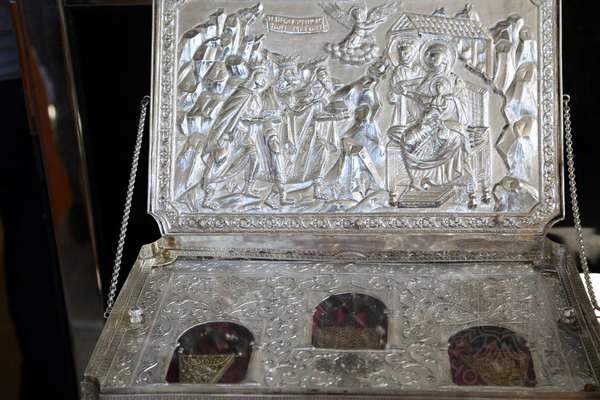History and present days

After the Dionysiou Monastery, there is the cape and the pit of Kalathas. The area is mentioned in a document of the Protos (1401), which defines the boundaries between the Monasteries of Dionysiou and of Saint Paul.
The latter is located in a wide valley. In the background there stands the pyramid of Athos, the great mountain with its impressive folds of grey and white rocks. In the gorges of Athos, the snow remains unmelted until June. The vegetation of the valley is dense. The Monastery of Saint Paul dominates the view by its monastic structure, built on a rock of 150 m. altitude. Behind it there rises the fortification wall. It is located at the confluence of two streams, the Xeropotamou stream, which is large and descends from the slopes of Mount Athos, and a smaller one which flows on the left. The power of the two streams is evident by the huge stones of the beach, as well as the roar of the water that one can hear while climbing up to the monastery from the arsanas.
The natural disaster that struck the Gregoriou Monastery on September 1st of 1820-1821, has also affected the Monastery of Saint Paul. It mainly caused great damage to the crops and the buildings of the old arsanas, on the left side of the beach. Another major downpour in 1911 uprooted more than 700 lime trees, it swept away garden houses and chapels. From the old arsanas there survives the seaside tower, dilapidated and in poor condition due to collapses. Originally it stood right on the beach, next to the mouth of the torrent. The tower (14th century) was built at the same time with the renovation made by the Serbian owners. On its western side it has a fortified courtyard, which is a 15th century structure. The walls are made of clay masonry using large river pebbles. On the sixth floor, there can be seen three niches testifying to the existence of a chapel. An engraving from 1798 shows a rope connecting the coastal tower to the monastery for the transportation of water by buckets.
The new arsanas (1882) is on the right side of the beach, right under the vineyards. It is a two-storey building. On the upper floor there is the chapel of Saint Demetrios. From the new arsanas there starts a car road that leads uphill to the monastery. The same path leads to the New Skete and the Skete of Saint Anna, passing through a small grove of groomed olive trees. In the past there was also access through a path that reached the cemetery church of All Saints. Leaving the carriage road and following the path, one has the opportunity to walk in royal footsteps.
In 1470, Maro, daughter of the Serbian ruler Brankovic, wife of the Sultan Murat II and stepmother of Mohammed II the Conqueror, reached the arsanas of the monastery bringing with her the Gifts of the Magi, that she rescued from the imperial treasury. She began to ascend to deposit them in the monastery, that in the past was benefited by her father in many ways. At that time, she heard the voice of the Virgin Mary saying: "Maro, Maro, proceed no further for the monastery is inhabited by monks. You are a woman and no other Queen than me can reign here." The Virgin Mary appeared before her, forbade her to continue and ordered Maro to depart immediately. When she spoke of her royal title, Theotokos declared that She is the only Queen of Athos. The Gifts were given to the elders of the monastery. At the spot where the Virgin Mary appeared, there was built the Sanctuary of Maro.
From a certain distance, the Monastery of Saint Paul appears much larger than it actually is. The north wing (15th century), which incorporates the imposing tower (first half of the 16th century), is the oldest part of the monastic structure and used to be the original core of the monastery. Until the beginning of the 19th century the wings covered a small area. The present form is a result of renovations and reconstructions carried out during the 19th and 20th centuries. Its floor plan forms an irregular pentagon. The architectural morphology was shaped according to the form of the terrain.
History
The Monastery of Saint Paul has an impressive history and course in time.
According to tradition, in its present location there was in ancient times a sanctuary of Apollo. In its ruins, a monk called Stephen built in 337 a small church dedicated to the Presentation of the Virgin Mary. The monastery is said to have been decorated by the frescoes of painters from Olynthus. When it was later destroyed by an earthquake, it was restored and repainted by Roman artists. The revival of the monastery took place in 830. In 987 the monastery was expanded. It was then recognized as Monastery of Xeropotamou, while the present-day Monastery of Xeropotamou was known as the Monastery of Saint Nikephoros. The name "Saint Paul" first appears in 1071, in a document that holds the signature of the monk Michael "from the Monastery of Saint Paul". The name prevailed from 1108. However, a golden bull of Michael VIII Palaiologos (1259), mentions the monastery as a place dedicated to Christ the Savior. The monastery existed during the reign of Andronicus II Palaiologos (1283). It suffered almost total destruction and looting by the Catalan pirates (1303-1309), resulting in its downgrading to a cell of the Monastery of Xeropotamou.
In a document of the Protos (1316), the abbot of the monastery is mentioned as the 39th, while in the Third Typikon of Mount Athos (Manuel II, 1394) the monastery is ranked 18th among the 25 communities. In 1365 it was granted by the Monastery of Xeropotamou to the Serbian monks Gerasimos Radonia and Antonios Pagasis (Bagas), who restored and renovated it. The Monastery of Saint Paul was now one of the most important Athonite communities. The presence of Stephanos Dusan in Mount Athos seems to have played an important role in its growth. The sigil of the Patriarch Matthew (1404) refers to it as an “ancient” structure, proving its earlier existence. The presence of Serbs was strong until the 20th century, so that the seal of the monastery had a bilingual inscription, in Greek and Serbian.
In the 15th century the monastery was supported by Gerasimos' brother Nicholas, by Radoslav Sabia (1405), by John VII Palaiologos, who was then bishop of Thessaloniki (1406), by the Serbian ruler George Bronkovic, who built a new, larger church dedicated to Saint George, by his brother Lazarus (1416) and by John VIII Palaiologos (1437). At that time, the monastery acquired part of the forest of the deserted Monastery of Amalfi, on the eastern slope of Mount Athos. Benefactors of the monastery were also Greek and Romanian rulers of the Danubian countries. It was also assisted by the Russian Tsars Ivan the Terrible, Alexei Mikhailovich, Peter the Great, and Elizabeth Petrovna. Thanks to their assistance, the monastery experienced a great period of prosperity, which continued until the 17th century. At that time about 200 monks were settled there. When in 1661, due to debts, the Holy Community decided to sell a number of cells, the Monastery of Saint Paul was able to buy 4 of them. However, in order to cope with heavy taxation and to service its exorbitant debt, it was forced to sell a large part of its property.
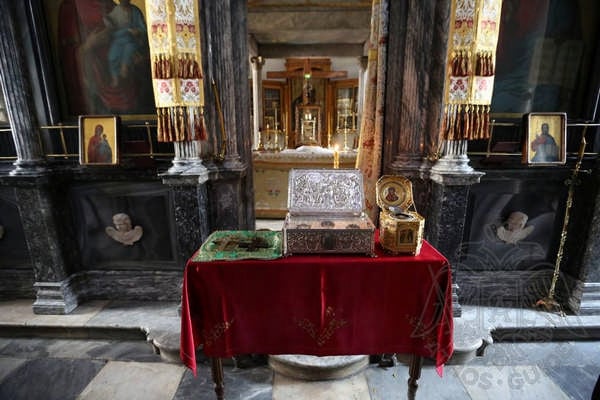 The active sacristan Gregory managed to raise a considerable income for the monastery through fundraising (late 18th century). At the beginning of the 19th century, another monk from Mount Athos, Anthimos Komnenos, abbot of the metochion in Romania, began the work of renovation, while he also donated to the monastery lands in Kassandra and Thassos. The financial situation got worse in the 1821-30s, when the monastery was deserted due to the settlement of Ottoman troops. Of great importance was the contribution of the Russian Tsars Alexander I and Nicholas I. The monastery was severely damaged by successive fires and floods. In the great fire of 1902, there was burned down much of the southwest wing, which had been completed only in 1895. It was then that monk David died trying to save most of the library’s archive. The monastery was also seriously damaged by the earthquake of 1905. This was followed by the flood of 1911, after which the monastery was essentially rebuilt from the foundations. The monastery reverted to the cenobitic system in 1839 with a sigil of the Patriarch Gregory VI (1840). The first abbot of the cenobitic community was Archimandrite Stephanos Dionysiatis. At least eight of the 21 abbots of the monastery (1839-present), including the current abbot, are coming from the island of Cephalonia.
The active sacristan Gregory managed to raise a considerable income for the monastery through fundraising (late 18th century). At the beginning of the 19th century, another monk from Mount Athos, Anthimos Komnenos, abbot of the metochion in Romania, began the work of renovation, while he also donated to the monastery lands in Kassandra and Thassos. The financial situation got worse in the 1821-30s, when the monastery was deserted due to the settlement of Ottoman troops. Of great importance was the contribution of the Russian Tsars Alexander I and Nicholas I. The monastery was severely damaged by successive fires and floods. In the great fire of 1902, there was burned down much of the southwest wing, which had been completed only in 1895. It was then that monk David died trying to save most of the library’s archive. The monastery was also seriously damaged by the earthquake of 1905. This was followed by the flood of 1911, after which the monastery was essentially rebuilt from the foundations. The monastery reverted to the cenobitic system in 1839 with a sigil of the Patriarch Gregory VI (1840). The first abbot of the cenobitic community was Archimandrite Stephanos Dionysiatis. At least eight of the 21 abbots of the monastery (1839-present), including the current abbot, are coming from the island of Cephalonia.
In addition to Saint Paul of Xeropotamou and a number of enlightened abbots who essentially emerged as co-founders (Anthimos Komnenos, Sophronios Kalligas), the monastery was also home to the young martyrs Pachomios and Constantine of Agarene, the Kausokalyvites. Hieromonk Simeon from Tripoli in Arcadia (1829-1905) was elected abbot of the Gregoriou Monastery. The monk Gerasimos Menayas (1881-1957) also lived in the monastery at the end of his life.
Swimming
On the pier of the arsanas there is the sign “Swimming is strictly forbidden”. However, there was no such prohibition in the past. Robert Byron and his friends (1926) went swimming almost every day when they visited Mount Athos.
— We swim everyday Father Stephen. Are there dogfish?
— Dogfish? Armies of them!
— Have you seen them yourself?
— Me? No, I haven't, but there are many.
— But if you haven't seen them, how do you know?
— How do I know? They ate a deacon two hundred and fifty years ago. Then, when the shark was caught, they found the deacon inside it.
Robert Byron, The Station. Athos, Treasures and Men, 1927.
Saint Paul of Xeropotamou (915 - before 1030)
Saint Paul was a son of the royal family of the Ragave. He was called Procopius and was son of the emperor Michael I. Fearing that he might claim the throne, Leo V the Armenian emasculated Procopius in order to exclude him. After his brilliant studies, Procopius renounced the secular life, became a monk named Paul and settled in Mount Athos close to the hermit Cosmas (10th century), in the area of the present-day New Skete. During the reign of the Emperor Romanos Lekapenos, he built a monastery on the site of the present-day Monastery of Saint Paul and dedicated it to Saint George. He also secured generous sponsorships from his royal relatives. Despite his strong opposition to the introduction of cenobitic monasticism by Saint Athanasios the Athonite, he signed the Typikon of 1071 and was the founder of two monastic communities (Saint Paul and Xeropotamou). He was buried in the Myrelaion Monastery in Constantinople.
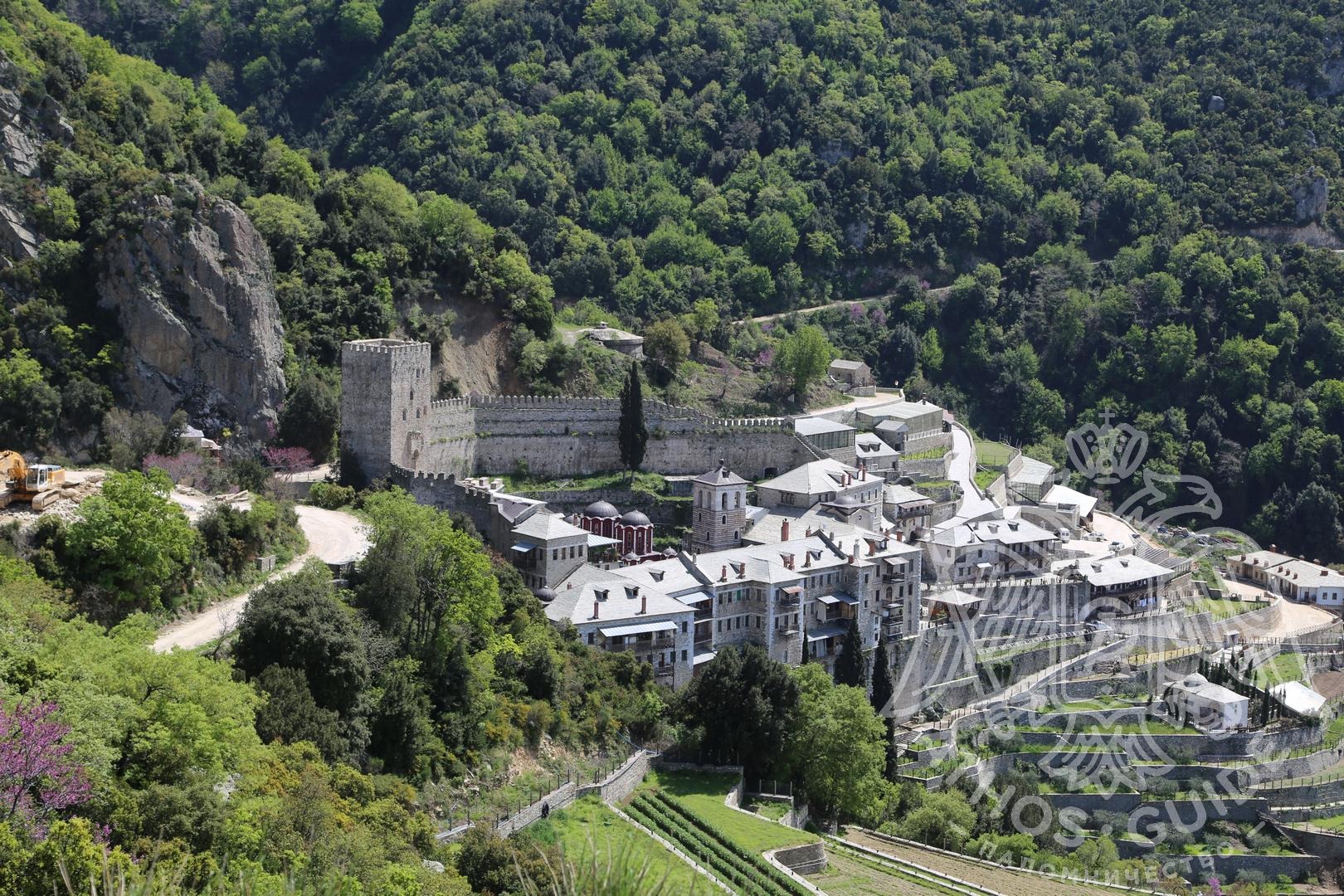
.jpg) Opposite the main entrance of the Monastery of Saint Paul, there is a pavilion that offers an excellent view of the peninsula of Sithonia. On the southeast there is a two-storey building. On the ground floor there used to be stables, while on the first floor there were guest rooms. In 1997 the whole building was converted into an archontariki. Opposite the pavilion there is a fountain (1804). The slope below is laid out with beautiful gardens and vines. There is located the cemetery church (All Saints, 1795). It is structured according to the type of cruciform with a dome. On a terrace higher than the monastery building complex (south-east), there is the old cemetery church, which is currently used as the chapel of Saint Demetrios. After the construction of the new church, it was abandoned and fell into ruins. It was restored to its original form in 1988. It is very similar to the corresponding cemetery churches of the monasteries of
Opposite the main entrance of the Monastery of Saint Paul, there is a pavilion that offers an excellent view of the peninsula of Sithonia. On the southeast there is a two-storey building. On the ground floor there used to be stables, while on the first floor there were guest rooms. In 1997 the whole building was converted into an archontariki. Opposite the pavilion there is a fountain (1804). The slope below is laid out with beautiful gardens and vines. There is located the cemetery church (All Saints, 1795). It is structured according to the type of cruciform with a dome. On a terrace higher than the monastery building complex (south-east), there is the old cemetery church, which is currently used as the chapel of Saint Demetrios. After the construction of the new church, it was abandoned and fell into ruins. It was restored to its original form in 1988. It is very similar to the corresponding cemetery churches of the monasteries of 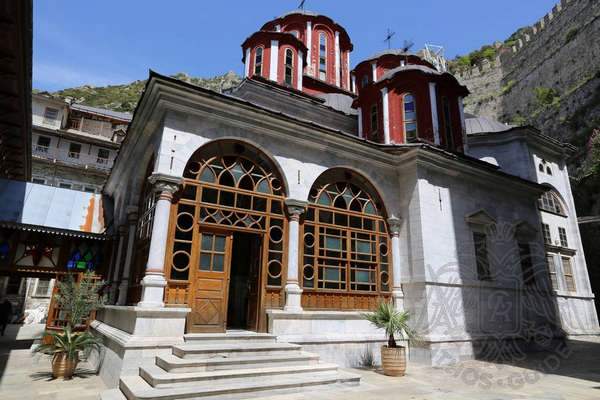

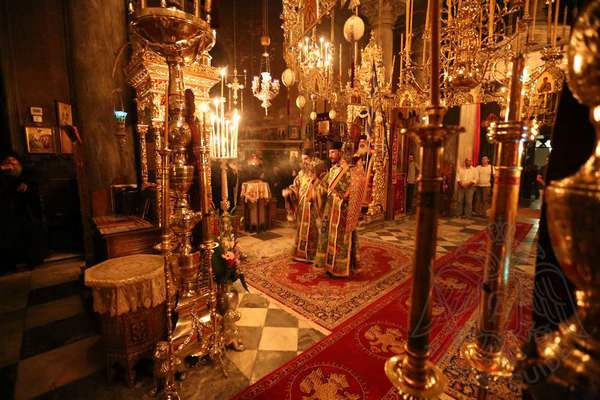 It has six floors above the ground level. The northern and eastern facades retain their fortified character, while the southern and western facades, with their windows, give the impression of a residence. In the past years (18th century), it had a wooden roof. Renovations in the 1960s replaced the wooden floors and the roof with other material.
It has six floors above the ground level. The northern and eastern facades retain their fortified character, while the southern and western facades, with their windows, give the impression of a residence. In the past years (18th century), it had a wooden roof. Renovations in the 1960s replaced the wooden floors and the roof with other material.